Students should refer to Sound ICSE Class 10 Physics Notes and solutions below. Our teachers have provided numerical problems and solutions for chapter Sound in ICSE Class 10 Physics. These notes are really useful if you are preparing for ICSE exams. concise physics class 10 solutions are also very important for Physics students.
ICSE Class 10 Physics Sound Numerical Problems
Students can refer to the Numerical Problems prepared for Chapter Sound in Class 10 ICSE. These notes will be really helpful for the students giving the Physics exam in ICSE Class 10. Our teachers have prepared these concept notes based on the latest ICSE syllabus and ICSE books issued for the current academic year. Please refer to Chapter wise notes for ICSE Class 10 Physics provided on our website.
Sound ICSE Class 10 Physics Revision Notes
Reflection of Sound – Echo, Resonance.
Revision Notes
Range of hearing :
The average frequency range over which the human ear is sensitive is called audible range. The audible range of sound for human beings is from 20 Hz to 20000 Hz. As people grow older, their ears become less sensitive to higher frequencies.
➢ Infrasonic Sound :
The sound of frequencies lower than 20 Hz are known as infrasonic sounds or infrasound, which cannot be heard by human beings. It is generated during earthquake.
➢ Ultrasonic Sound :
The sounds of frequencies higher than 20000 Hz are called as ultrasonic sounds or ultrasound which cannot be heard by human beings. Dogs can hear ultrasonic sounds of frequency upto 50000 Hz. This is why dogs are used for detective work by the police. Monkeys, bats, cats, dolphins, leopard and tortoise can also hear ultrasonic. Dolphins, tortoise and rats can also produce ultrasonic sounds as well as hear ultrasonic sound.
➢ Reflection of Sound Waves :
The returning back of the sound wave on striking a surface such as wall, metal sheet, etc., is known as reflection of sound wave. It does not require a smooth and shining surface like mirror. The reflection of sound takes place in accordance with the same laws as those governing the reflection of light. The condition for reflection of sound wave is that the size of the reflecting surface must be bigger than the wavelength of the sound wave.
➢ Echo :
It is a reflection of sound, arriving at the listener sometime after the original sound. Basically, a reflected sound from an (distant) object is heard after the original sound has ‘‘died down.’’ e.g., The echoes are produced by the bottom of a well, by a building or by the walls of an enclosed room and an empty room.
➢ Bats and dolphins make use of the phenomenon of echoes in nature.
➢ Trawlerman makes use of echoes for finding the depth of ocean beds or for detecting submerged objects.
➢ Radar and Sonar also make use of echoes for finding the position and distance of an enemy airplane, under water dangers or for sound ranging.
➢ A tuning fork is made by shaping a metal piece in the form shown. It enables us to produce a pure sound note.
➢ Conditions for formation of echo/hearing the echo distinctly :
(i) The size of the obstacle/reflector must be large compared to the wavelength of the incident sound (for reflection of sound to take place).
(ii) The distance between the source of sound and the reflector should be atleast 17 m ( so that the echo is heard distinctly after the original sound is over).
(iii) The intensity or loudness of the sound should be sufficient for the reflected sound reaching the ear to be audible. The original sound should be of short duration.
➢ Echoes also find use in medical field for imaging of human organs (womb, liver, uterus).
➢ Echoes find application in SONAR (Sound navigation and ranging). In order to find the distance of obstacle from ship, waves are transmitted and then reflected waves are received by the receiver.
Let the distance of the obstacle from source of sound be “d” then,

Where,
v is the velocity of ultrasonic waves in water
t is the time between sending and receiving of waves
➢ The periodic vibrations of a body of decreasing amplitude in presence of a resistive force are called the damped vibrations. Examples include oscillations of simple pendulum in air.
➢ The periodic vibrations of a body of constant amplitude in the absence of any external force on it, are called the free vibration. Examples include vibration in instruments like sitar, violin when they are plucked.
➢ The vibrations of a body which take place under the influence of an external periodic force acting on it are called the forced vibrations.
➢ The frequency of vibrations of a body executing forced vibrations equals to the frequency of the applied periodic force. Examples include vibrations produced in the diaphragm of microphone sound box with frequency matching the speech of speaker.
➢ Resonance is a special case of forced vibrations. When the frequency of an externally applied periodic force on a body is equal to its natural frequency, the body readily begins to vibrate with an increased amplitude. This phenomenon is known as resonance. The vibrations of large amplitude are called the resonant vibrations. For example, tuning of a radio is based on resonance.
➢ Condition for resonance :
Resonance occurs only when the frequency of the applied force is exactly equal to the natural frequency of the vibrating body.
➢ Difference between the free and damped vibrations :

➢ Difference between the free and forced vibrations :

➢ Difference between the forced and resonant vibrations :

Characteristics of Sound
➢ Revision Notes
Characteristics of Sound Waves
Sound waves can be described by its :
• Wavelength
The distance between the two consecutive compressions (C) or two consecutive rarefactions (R), is called the wavelength. Wavelength is the minimum distance in which sound wave repeats itself. Its SI unit is metre (m). It is denoted by letter ‘λ‘.
• Frequency
The number of complete waves (or oscillations) pr
oduced in one second is called frequency of the wave. It is the number of vibrations that occur per second. The frequency of a wave is fixed and does not change even when it passes through different substances. Its SI unit is Hertz. (Hz). It is denoted by letter ‘v’ or ‘f‘.
•Time Period
The time taken by two consecutive compressions or rarefactions to cross a fixed point is called the time period of the sound wave. In other words, the time required to produce one complete wave (or oscillations) is called time period of the wave. It is denoted by symbol T. Its SI unit is second (s). The time period of a wave is the reciprocal of its frequency. i.e.,

• Amplitude
The maximum displacement of the particles of the medium either side from their original mean positions on passing a wave through the medium, is called amplitude of the wave. It is used to describe the size of the wave. It is usually denoted by the letter A. Its SI unit is metre (m). The amplitude of a wave is the same as the amplitude of the vibrating body producing the wave.
• Speed
The distance travelled by a wave in one second is called speed of the wave or velocity of the wave. Under the same physical conditions, the speed of sound remains same for all frequencies. It is represented by letter ‘v’.
Its SI unit is metre per second (m/s or ms-1).
➢ Relationship among Speed, Frequency and Wavelength of a Wave

Suppose distance travelled by a wave is λ (wavelength) in time T; then the speed is given by

We know that, f=1 / T
Therefore, V = λ × ν or (V = νλ)
➢ Or Speed (or velocity) = Frequency × Wavelength
➢ Three main characteristics of a given musical sound are (i) loudness, (ii) pitch and (iii) quality or timbre.
➢ Loudness is the property by virtue of which a loud sound can be distinguished from a faint one, both having the same pitch and quality.
➢ Loudness is proportional to the square of amplitude of the wave.
➢ Pitch is that characteristic of sound by which an acute (or shrill) note can be distinguished from a grave or flat note.
➢ Pitch of a note depends on its frequency. Two notes sounded on the same instrument with same amplitude, will differ in pitch when their vibrations are of different frequencies.
➢ Quality (or timbre) of a sound is that characteristic which distinguishes the two sounds of the same loudness and same pitch, but emitted by two different instruments.
➢ The quality of a musical sound depends on the wave form.
➢ Thus the quality of a musical sound depends on the number of the subsidiary notes and their relative amplitudes present along with the principal note.
➢ Comparison between music and noise
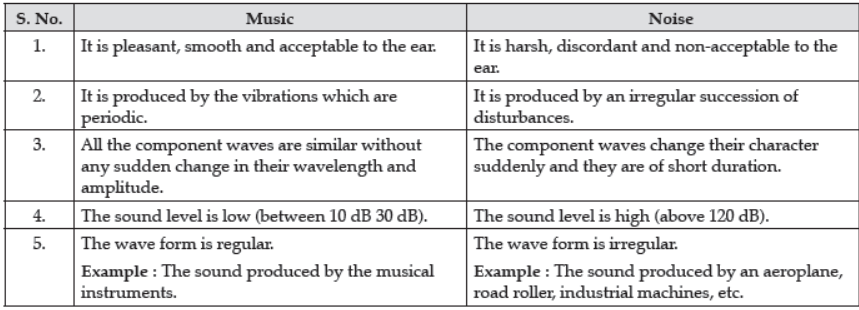
IMPORTANT FORMULAS
1) Relation between speed of sound distance of reflection body from source of sound and time for hearing echo

2) In RADAR system
D =CXT / 2 where ‘c’ is the speed of light in vacuum
‘t’ is the time and ‘d’ is the distance to be calculated.
The speed of radio waves is the same as that of light in vacuum.
3) The Frequency of a vibrating string depends upon the length of the string, tension in the string and the mass per unit length of the strong.

Where L = Length of the string,
T= tension in the string and
M = mass per unit length of string.
4) Loudness of sound increases with the intensity of sound according to
Weber-Fechner’s Law,
According to this Law,
L X Log10 1, or
L = K log10 1, where ‘L’ is called sensation of loudness and I is the intensity of sound.
5) 𝑉 = 𝑓𝜆
Where f = n = frequency (Hz)
v= wave velocity ms-1
λ = wavelength (m)
6) fA / fB = 𝜆B / 𝜆A
(If velocity or the medium is same for two waves A and B)
7) In case of guitar t2 →Length of longer wire.

‘f1’ is frequency of longer wire,
‘f2’ is frequency of smaller wire
8) Frequency of a tuning fork
𝑓 = 1 /1
Where ‘f’ is the frequency of tuning fork and ‘T’ is the Time of oscillation of tuning fork in see.
9) Relation between frequency and density of stretched string, when all other variable are constant.

Where ‘f’ is frequency ‘d’ is density
10) SONAR stands for sound Navigation and ranging. Sonar works on the Principle of echoes.
Depth of sea is calculated by this system using the formula.
𝑑 = 𝑉𝑡/2
11) The time taken to hear an echo can be given by the relation :

Here
t= time taken to hear an echo=01.s
d= distance between the listener and the surface of reflection of sound and
v= speed of sound = 340 ms’
2d= the distance covered by the sound to reach the reflection surface and to come back
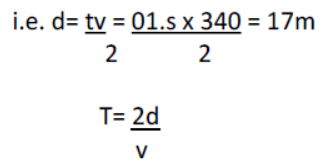
12) Weber- Fechner’s law: Loudness of sound increases with the intensity of a sound according to Weber –Fechner’s Law.
L = K log10 I
L is called sensation of loudness and I is the intensity of sound.
13) Unit of Loudness: The loudness is generally expressed in decibel (dB) Unit of sound is decibel.
● The unit of loudness is named after Scientist Alexander Graham Bell who invented the telephone.
● Sound level (in dB) =

● Where I is the intensity of sound and I0 is the zero level sound and it is equal to 10-12 Wm-1 at the frequency of 100 Hz.
● Any person who is constantly exposed to the sound level above 120 dB, complains of headache and may suffer from loss of hearing.
● Examples of Harmful sounds: Thunder- 110dB, Pop Concert- 120 to 140 dB, Aeroplane taking off – 130 to 140 dB.
POINTS TO REMEMBER
1. If a body vibrates more than 20 times and less than 20,000/ min we can hear it.
2. 1 vibration = 2beats, 2 oscillation, 2 swings.
3. If the frequency of a sound is between 20 Hz to 20,000 Hz then human can hear it.
4. So audible range is 20Hz to 20,000Hz it is called limit of audibility.
5. Sounds having frequency less than 20 Hz are called infrasonic or subsonic.
6. Sounds having frequency more than 20,000 Hz are called ultrasonic.
7. Sound waves travel with a speed of 332 ms’ in air (340 ms’ taken generally).
Quick Guide To Units Used In Sound:
● Audible range → 20 Hz to 20,000Hz.
● Unit of amplitude → metre
● Unit of velocity of wave → ms-1
● Unit of wavelength → metre
● Unit of time period → second (s)
● Unit of frequency → Hertz (Hz)
● Unit of loudness level → phon
● Velocity of electromagnetic wave → 3 X 108 ms -1 in vacuum.
1Hz = 1 Vibration
1KHz = 103 Hz
1MHz = 106 Hz
1Giga hertz = 109 Hz
Angstrom unit (Å): The unit used to measure wavelength of electromagnetic spectrum is called
angstrom unit. One angstrom (1 Å) = 10-8 cm = 10−10 metre
Range of Electromagnetic Waves:
i. Ultraviolet Rays – Range 100 Å
3900 Å
ii. X- Rays – 100 Å to 10-2 Å
iii. Gamma Rays – 10-2 Å to 10-3 Å
The range of electromagnetic waves which cause sensation of sight is 7800 Å to 3900 Å.
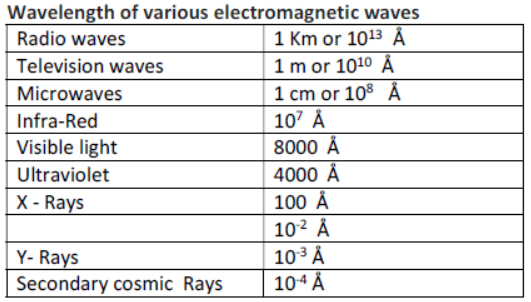

The frequency range of infrasonic, audible and ultrasonic waves:
Audible range = Frequency range / 20 Hz to 20,000 hz
Ultrasonic above – 20,000Hz
Infrasonic – below 20 Hz
The order of wavelength of visible light and audible sound:
Wavelength of visible light is of the order of 6 X 10-7 m and audible sound in air varies from 17 X 10-3 m to 17m
We know that wavelength 𝜆 = V / v
For visible light (V= 5 X 1014 +12)

Speed of Waves:
SOUND WAVE LIGHT WAVE
Speed – 332 m/s Speed- 3 X 108 m/s

IMPORTANT PROBLEMS & SOLUTIONS
1) The velocity of sound in air is given as 330ms. A man claps his hands while standing at a distance of 165m from a high wall.
i. Will he hear a distinct echo of his clap?
ii. Given reason for your answer
i. Yes, he will hear a distinct echo of his clap.
ii. Time after which echo is heard = 2d / v = 2x165m / 330ms = 1 second
=1 second
As the minimum time required for hearing echo is 0.1s & the time calculated above is 1 second, therefore the man can hear echo.
2) A man stands at a distance of 255m away from a wall. He shoots a rifle and hears an echo
after 1.5 sec. calculate the velocity of sound.
Given:
Distance = d = 255m
Time= t= 1.5 sec
Velocity of sound = V= 2d/t

3) Without changing the length of a string, its tension is increased 4 times. What happen to its frequency of vibrations?
Ans. Frequency of vibrations will increase by 2 times because F X √𝑡
4) Assuming velocity of sound at room temperature to be 340 ms-1 (calculate the wavelength of wave emitted by a tuning fork of frequency 512.
Sol.
(Hint: λ = v/f )
Velocity = V = 340 ms-1
Frequency = f = 512

5) Two waves take one second to go from A to B. Calculate the wavelength?
Sol.
From given figure AB = 42 cm
Wavelength of (a) = 42/3= 14𝑐𝑚
Wave length of (b) = 42/6 = 7𝑐𝑚
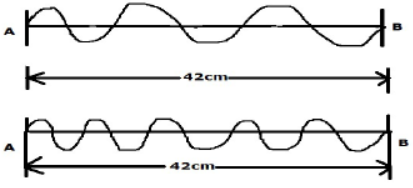
6) What is the order of wavelength of visible light and audible sound?
We know that wavelength λ = v/v
For visible light (V = 5X 1014 Hz)
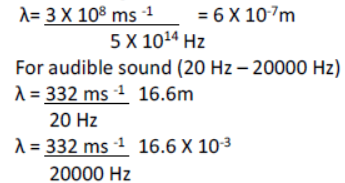
Wavelength of visible light is of the order of 6 X 10-7m and audible sound in air varies from 16.6 X 10-3 m to 16.6 m.
7) The audible range of frequencies for a normal human being is 20 to 20,000 Hz.
8) Minimum distance to hear an echo is 17m.
9) To hear an echo clearly or distinctly, the minimum distance between the listener and the reflector of sound is 17m.
10) The vocal sound made by the bats have frequencies ranging from 50 to 50,000 hertz per sound.
11) The sensation of any sound persists in our ear for about 0.1 second.
12) The distance between a source of sound and a reflecting surface is 0.34km. The echo will reach the source after reflection after approximately
(a) 2s
(b) 0.5s
(c) 1s
(d) 0.25s
Ans (a)
13) A person standing between two vertical cliffs and 480m from the nearest cliff shouts. He hears the first echo after 3 sec and the second echo 2 sec later.
(a) Calculate the speed of sound
(b) The distance of the other cliff from the person.

Ans. Given
d1= 480m, t1 = 2 sec, t2 = 3 sec ,d2 =? V =?

Distance of other cliff from the person is 720m [ANS]
14) A type of electromagnetic wave has wavelength 50Å.
i. Name the wave
ii. What is the speed of the wave in vacuum?
Sol.
i.X-rays
ii.3 X 108m/s [ANS]
15) Radar sends a signal to an aircraft at a distance of 30km away and receives it back after 2 X10-4 second. What is the speed of the signal?
Sol.
Given: Distance of aircraft = 30 Km = 30,000 m.
Total distance = 2 X 30,000 = 60,000 m.
Time taken = 2 X 10-4 second
Hence speed of sound V
= distance travelled(2d)
Time taken (t)
= 60,000 / 2 X 10-4 = 30,000 X 104 m/s
= 3 X 108 m/s [ANS]
b. A sound made on the surface of a lake takes 3s to reach a boatman. How much time will it take to reach a diver inside the water at the same depth? Velocity of sound in air = 330m
Velocity of sound in water = 1450 ms-1
Sol. Depth of lake = V X t = 330 X 3 = 990m.
Depth of diver = 2 X 990m = 1980m.
Time taken by sound in water = 990 /1450 = 0.68s
Total time = 3+ 0.68 = 3.68 seconds. [ANS]
16) An observer stands at a certain distance away from a cliff and produces a loud sound. He hears the echo of sound after 1.8s. Calculate the distance between the cliff and the observer if the velocity of sound in air is 340 ms-1
Sol. Given: V = 340 m/s , t = 1.8 s ,
Distance travel by sound = 2d.
Distance = speed X time
2d = V X t
D = V X t/2 = 340 X 1.8/2 = (170 X 1.8) m = 306 m
The distance between the cliff and the observer is 306 m [ANS]
17) A man standing between two cliffs produces a sound and hears two successive echoes at intervals of 3 sec and 4 sec respectively. Calculate the distance between the two cliffs. The speed of sound in air is 330 ms-1 .
Sol.
We know
V = 2d/t
Or 2d = V x t
Now d1 = 330 X 3/2 = 495 m & d2 = 330 X 4/2 = 660m
Distance between the two cliffs = (495 + 660) m = 1155m [ANS]
18) A man standing 25m away from a wall produces a sound and receives the reflected sound.
Calculate the time after which he receives the reflected sound if the speed of sound in air is 350ms-1
Sol.
t =2d/v = 2 𝑋(250m / 350) ms-1 = 0.142 Seconds [ANS]
19) A pendulum has a frequency of 5 vibrations per sec. An observer starts the pendulum and fires a gun simultaneously. He hears the echo from a cliff after 8 vibrations of the pendulum.
If the velocity of sound in air is 340,m-1 , what is the distance between the cliff and the observe?
Sol.
5 vibrations take 1 sec.
8 vibrations will require 1/5𝑋 8/5 = 1.6 𝑠𝑒𝑐
As V = 2d/t or 340 = 2d/t
d = 340 X 1.6/2 = 272m [ANS]
20) A) A certain sound has a frequency of 256 Hz and a wavelength of 1.3. calculate the speed with which this sound travels.
Sol.
We know that
V = n λ here, n = 256 Hz
And λ = 1.3 m
Speed of sound v= 256 X 1.3 or V= 332.8 m/s [ANS]
B) What difference would be felt by a listener between this sound and another sound travelling at the same speed but of wavelength 2.6m?
Sol.
The fundamental frequency of other sound wave will be 332.8 / 2.6 = 128 Hz [ANS]
(Speed of first sound = 332.8 m/s)
Hence there may be difference of overtones in the two sounds. Thus the quality in the two cases may be different. Second sound will be less shrill, sharp and more flat of wavelength.
21) Radar is able to detect the reflected waves from an enemy Aeroplan after a time interval of 0.15 milli seconds. If the velocity of the wave is 3 X 108 ms-1, calculate the distance of Aeroplan from the radar.
Sol.
Given V= 3 X 108 ms-1, and
T = 0.015 milli seconds = 0.015 X 10-3 s
Let d be the distance of Aeroplane from the radar.
Then total distance travelled by the waves = 2d.
V = 2d/t
Or d = vt/2
= 3 X 108 X 0.015 X 10-3 s = 2250m.
Thus the distance of Aeroplane from the radar is 2250m. [ANS]
22) A man stands at a distance of 255 m away from a wall. He shoots a rifle and hears an echo after 1.5s calculate the velocity of sound.
Sol.
Given distance, d= 255m
And time t = 1.5s
Velocity of sound, V = 2d/t = 2𝑋 (255/1.5) = 340𝑚/𝑠 [ANS]
24) A worker lives at a distance of 1.32 Km from the factory. If the speed of sound in air be 330 m/s, how much time will the sound of factory siren take to reach the worker?
Sol.
Distance of the factory = 1.32 km
= 1.32 x 1000 m = 1320 m
Speed of sound = 330 m/s
Time for siren sound to reach the worker

25) A tank, travelling at the rate of 72 Km/ hr , towards a hill fires a shot and its driver hears the echo after 4.5 second. Find the distance of tank from the hill when the shot was fired.
Velocity of sound = 340 ms-1.
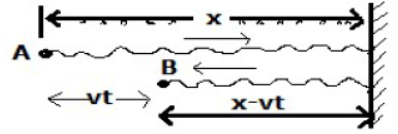
Sol.
Let A be the position of the tank when shot was fired and B be its position when its echo was received.
AB = Vt
Where V = velocity of tank
t = time for echo
let 𝑥 be the distance between the tank & hill.
Distance travelled by sound = 𝑥 + 𝑥 − 𝑣𝑡 = 2𝑥 − 𝑣𝑡
2𝑥 − 𝑣𝑡 = V x t where V = velocity of sound
Here V = 72 km h-1 = 72 x 5/8 ms-1
= 20ms-1
V = 340 ms-1 , t = 4.5 sec
2𝑥 = (20 𝑋 4.5 ) = 340 𝑋 4.5
or, 2𝑥 = ( 340 𝑋 4.5 ) + (20 𝑋 4.5 )
or, 2𝑥 = 4.5 𝑋 360
or 𝑥 = 4.5 X 360/2 = 810m [ANS]
26) Radar sends a signal to an aircraft at a distance of 30km away and receives it back after 2 X 10-4 second. what is the speed of the signal.
Sol.
Given: Distance of aircraft = 30 km = 30,000m
Total distance = 2 X 30,000 = 60,000m
Time taken = 2 X 10-4 sec
Hence speed of sound V
= Distance travelled (2d) /Time taken (t)
= 60,000 = 30,000 X 104 m/s
2X 10-4
= 3 X 108 m/s [ANS]
27) A person standing between two vertical cliff and 480m from the nearest cliffs shouts. He hears the first echo after 3s and the second is echo 2 second later calculate:
1. The speed of sound
2. The distance of the other cliff from the person.
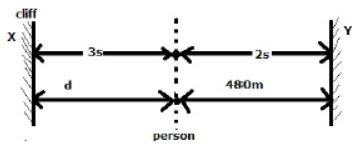
- Speed of sound V = 2d/t
𝑣 = 2 𝑋 (480m /2s
= 480 ms-1 [ANS]
- Distance of the other cliff from the person =
D = v x t/2 = 480 ms-1 X 3s /2 = (240 X 3) m
=720m[ANS]
28) An observer stands at a certain distance away from a cliff and produces a loud sound. He hears the echo of the sound after 1.8s. Calculate the distance between the cliffs and the observer if the velocity of sound in air is 340 ms-1
Sol.
Given: V = 340 m/s,
T = 1.8 seconds
Distance travelled by sound = 2d
Distance = speed X time
2d = v x t
D = v x t/2 = 340 X 1.8 /2 = 170 x 1.8
= 306 m [ANS]
29) A man standing between two cliffs produces a sound and hears two successive echoes at intervals of 3s and 4s respectively. Calculate the distance between the two cliffs.
Sol.
The speed of sound in the air is 330 ms-1
We know V =2d/t ,,
Or, 2d = V X t
D1 = 330 X 3 /2
and D2 =330 X 4 /2
D1 = 495 m and D2 = 660m
Distance between the two cliffs = 495m + 660m = 1155m
30) A man stands at a distance of 68m from a cliff and fires a gun. After what time interval will he hear the echo, if the speed of sound in air is 340 ms-1?
If the man had been standing at a distance of 12m from the cliff would he have heard a clear echo?
Sol.
1.Distance =68m, speed = 340 m/s
Time (t) = 2 X distance / Speed
t = 2 x 68 m = 0.4 second
= 340m/s [ANS]
2.No, minimum distance required for hearing an echo is 17m. [ANS]
31) A radar sends a signal to an Aeroplan at a distance 45km away with a speed of 3 X 108 ms-1 .
After how long is the signal received back from the Aeroplan?
Sol.
V =2d / t
t = 2 X 45 X 1000 / 3 X 108 = 3 X 10-4 s [ANS]
32) An observer stands at a distance of 850m from a cliff and fires a gun. After what time gap will he hear the echo if sound travel at a speed of 350ms-1 in air?
Sol.“
Given d = 850m, V = 350ms-1 , t = ?
We know that d =v x t/2
t = 2d/v = 2 X 850m/350ms-1 = 2 X 17m / 7 = 34/7 m
t = 4.86s
Time gap = 4.86s [ANS]
33) A man standing in front of a vertical cliff fires a gun. He hears the echo after 3 seconds. On moving closer to the cliff by 82.5m, he fires again. This time, he hears the echo after 2.5 seconds Calculate:
1. The distance of the cliff from the initial position of the man.
2. The velocity of sound.
Sol.
1.Let the distance between initial position of man and cliff be 𝑥 meter.
Time taken in travelling 2𝑥
Distance by sound = 3 sec [ANS]

When he moves 82.5m close to cliff,
Distance = 2 ( (𝑥 − 82.5)
Time = 2.5 sec
Speed of sound = 2(x- 82.5 /2.5) / 2.5
Now 2x/3 = 2(x – 82.5) /2.5 =or 5𝑥 = 6𝑥 − 495
Speed of sound = 2 X 495 /3 = 2 X 165 = 330 m/s [ANS]
34) Radar is able to detect the reflected waves from an enemy Aeroplane, after a time interval of 0.02 milli seconds. If the velocity of the waves is 3 X 108 ms-1, calculate the distance of the plane from the radar.
Sol.
Let ‘d’ be the distance of enemy plane from the radar. The waves from the radar travel a distance (d + d) 2d before being detected.
The time taken for this purpose is 0.02ms (or 2 X 10-5 s). Hence, velocity of waves is
V = 2d/t = 2d / 2X 10-5 s
or 2d / 2 X 10-5s = 3 X 108 ms-1
D = 3 X 108 ms-1 X 2 X 10-5s / 2
= 3 X 108 m = 3 Km
So distance of the enemy plane from the radar is 3 km [ANS]
35) The wavelength of waves produced on the surface of water is 20 cm. if the wave velocity is 24ms-1, Calculate:
1.The number of waves produced in one second and
2.The time required to produced one wave
Sol.
Given:
Λ = 20cm = 0.2m, V = 24ms-1
V =? , I =?
1. Number of waves produced in one second,
i.e., V = v/ λ = 24ms/s /0.2m = 120 s-1 [ANS]
2.Time required to produce one wave
T = 1/V = 1/120s-1 = 0.0083s [ANS]
36) The ratio of the amplitude of two waves is 4:9. What is the ratio of their intensities?
Sol. We know that intensity of a wave (I) X square of its amplitude (a)2.
i.e. I1/I2 = a12/a22
Hear a1/a2 = 4/9
I1/I2 = (4)2/(9)2 = 16/81
Ratio of the intensities of two waves is 16:81 [ANS]
37) A pendulum has a frequency of 5 vibrations per second. An observer stars the pendulum and fires a gun simultaneously. He hears the echo from a cliff after 8 vibrations of the pendulum. If the velocity sound in air is 340 ms-1, what is the distance between the cliff and the observer?
Sol.
Let the distance between the cliff and the observer is d
Vs = 340 m/s, t = 8/5 = 1.6s
We know that dco = Vs X t /2 = 340m/s X 1.6s / 2 = 272m [ANS]
38) A man standing 25m away from a wall produces a sound and receives the reflected sound.
Sol. (a) Calculate the time after which he receives the reflected sound if the speed of sound in air is 350ms-1
D = 25m
V = 350ms-1
Time t = 2d/V = 2 X 25m/350 ms-1 1m/7 ms-1
0.14 sec [ANS]
39) An observer stands at a distance of 850m from a cliff and fires a gun. After what time-gap will he hear the echo, if sound travels at a speed of 350ms-1 in air.
Sol .
Given speed V = 350ms-1 and distance ‘d’ = 850m,
V = 2d /ν
t = 2d /ν
= 2 X 850m /350ms-1
= 4.85 sec
The observer will hear echo after 4.85 sec [ANS]
40) A pendulum has a frequency of 5 vibrations per second. An observer starts the pendulum and fires a gun simultaneously. He hears the echo from a cliff after 8 vibrations of the pendulum. If the velocity of sound in air is 340 ms-1, what is the distance the cliff and the observer?
Sol.
5 vibrations take 1 sec
8 vibrations will require 1/5 𝑋 8 = 1.6 𝑠𝑒𝑐
Here, given that V = 340 m/s
As V = 2d/t or 340 = 2d/1.6
d = 340 X 1.6 /2
d = 272m
Distance between the cliff and the observer is 272m [ANS]
41) Radio waves of speed 3 X 108 m/s are reflected off the moon and received back on earth, the time elapsed between the sending of the signal and receiving it back at the earth’s surface is 2.5 seconds. What is the distance of the moon from the earth?
Sol.
Let ‘d’ be the distance of the moon from the earth.
Then radio waves, after being reflected from the moon surface travel a distance 2d in 2.5 seconds duration.
Hence 2d /t = 𝑣
Or 2d /2.5 = 3 𝑋 108 (V = 3 X 108 m/s & t = 2.5s given)
Or d = 3 X 108 X 2.5 /2 m
= 3.75 X 108 m
= 375,000 Km
Distance of the moon from the earth is 375,000 Km [ANS]
42) Radio waves of speed 3 X 108 m/s are reflected off the moon and received back on the earth, the time elapsed between the sending of the signal and receiving it back on the earth’s surface is 2.5 seconds. What is the distance of the moon from the earth?
sol.
We know that d = v x t /2
Where d is the distance of the moon from the earth.
V is the speed of radio waves = 3 X 108 ms-1
T is the time elapsed between the sending of the signal and receiving it back on the earth’s surface = 2.5s
D = 3 x 108 ms-1 x 2.5s / 2 = 3.75 x 108 ms-1
Distance of the moon from the earth is 3.75 x 108 ms-1 [ANS]
43) A certain sound has a frequency of 256 hertz and a wavelength of 1.3m.
1. Calculate the speed with which this sound travels.
2. What difference would be felt by a listener between this sound and another sound travelling at the same speed but of wave length 2.6m?
Sol.
1.We know that
V = nλ , here n = 256 Hz and λ = 1.3m
Speed of sound V = 256 x 1.3 or V = 332.8 m/s [ANS]
2. Fundamental frequency of other sound wave will be 332.8/2.6 = 128 Hz [ANS]
Hence there may be difference of overtones in the two sounds. Thus the quality in the two cases may be different. Second sound will be less shrill, sharp and more flat of wavelength.
44) A certain sound has a frequency of 256 hertz and a wavelength of 1.3m calculate the speed with which this sound travels.
Sol.
We know that V = n λ
Here, n = 256 Hz and λ = 1.3m
Speed of sound V = 256 x 1.3
Or v = 332.8 m/s [ANS]
45) Calculate the minimum distance at which a person should stand in front of a reflecting surface so that he can hear a distinct echo. Speed of sound in air is 350ms-1.
Sol. We know d = vt/2 = 350 x .1 /2
= 17.5 m.
Here the minimum distance required for hearing a distinct echo is 17.5 m [ANS]
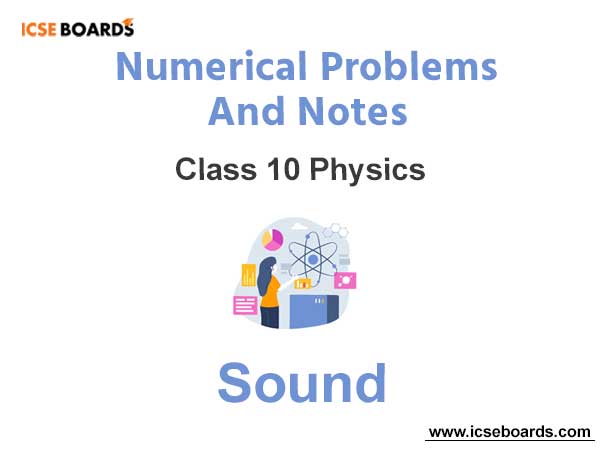
We hope you liked Sound ICSE Class 10 Physics Notes and solutions. If you have any questions please post them in the comments section below


